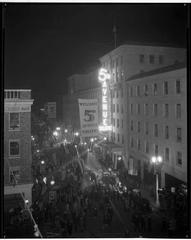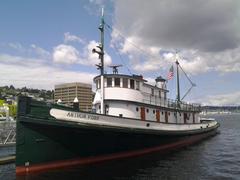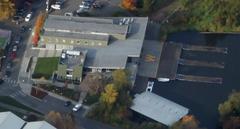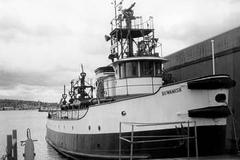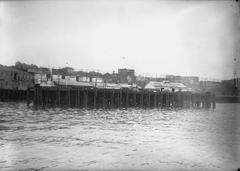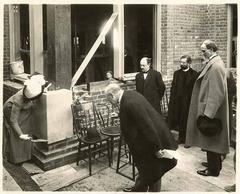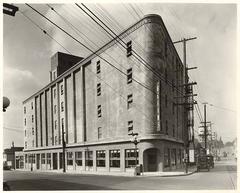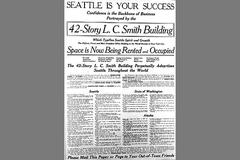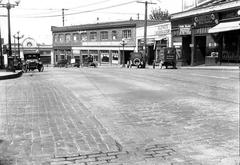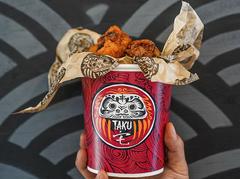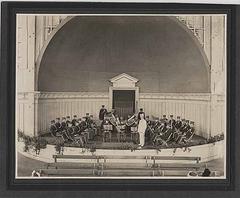
McGraw Square Visiting Hours, Tickets, and Seattle Historical Sites Guide
Date: 04/07/2025
Introduction to McGraw Square: History and Urban Significance
Nestled in downtown Seattle, McGraw Square is a vibrant urban plaza that seamlessly blends the city’s rich history with contemporary civic design. Dedicated to John Harte McGraw, a foundational figure in Washington State’s early political landscape, the square offers a unique lens into Seattle’s development—from its rapid 19th-century growth and the aftermath of the Great Seattle Fire to its modern role as a sustainable, pedestrian-friendly plaza.
McGraw Square is more than a commemorative space; it is a living urban hub. Visitors can admire the iconic John H. McGraw bronze statue, relax in thoughtfully landscaped rain gardens, and benefit from the square’s prime location at a major transit nexus adjacent to the South Lake Union Streetcar terminus. With 24/7 public access and no admission fees, the square invites both locals and tourists to experience a downtown oasis enriched by public art, dynamic events, and proximity to major attractions like Pike Place Market and Westlake Center. This guide provides comprehensive details on visiting hours, accessibility, nearby attractions, and travel tips to ensure a rewarding visit (SDOT Blog, Downtown Seattle Association, Seattle Parks).
Table of Contents
- Introduction
- Historical Background
- Design and Evolution of McGraw Square
- Visitor Information
- Civic Significance and Urban Renewal
- FAQ
- Conclusion
- Call to Action
Historical Background
Early Seattle and the Origins of McGraw Square
Seattle’s downtown core, including the site of McGraw Square, is steeped in a complex history shaped by Indigenous stewardship, rapid urbanization, and transformative civic projects. The land originally belonged to the Duwamish and Suquamish peoples, led by Chief Si’ahl (Seattle), before the arrival of settlers in 1851 initiated the city’s modern era (Postcards to Seattle, Seattle’s Early History 1851-1890).
The area’s development accelerated in the late 19th century, particularly after the devastating Great Seattle Fire of 1889. The city responded by rebuilding on elevated street levels, shaping the unique topography that characterizes downtown Seattle today (Postcards to Seattle).
The Legacy of John H. McGraw
John Harte McGraw, for whom the square is named, played a pivotal role in Seattle’s civic evolution. Serving as police chief, King County Sheriff, and the second Governor of Washington, McGraw’s contributions included championing the Lake Washington Ship Canal and facilitating the expansion of the University of Washington (SDOT Blog).
His legacy is immortalized in the square’s bronze statue—sculpted by Richard E. Brooks and unveiled in 1913—a symbol of Seattle’s respect for its founding figures (Seattle Parks, Wikipedia).
Design and Evolution
Originally one of Seattle’s smallest parks, McGraw Square was designed by the Olmsted Brothers, whose influence is still evident in the city’s green spaces (SDOT Blog). Its prime position at the intersection of 5th Avenue, Stewart Street, and Olive Way made it an early transit hub, a role that continues today with the South Lake Union Streetcar terminus at its edge (Seattle Department of Transportation).
A major redesign in 2011 transformed McGraw Square into a modern pedestrian plaza, closing a section of Westlake Avenue to traffic and incorporating sustainable features like rain gardens and recycled materials. The $900,000 redevelopment prioritized pedestrian safety, accessibility, and environmental stewardship (SDOT Blog).
Visitor Information
Visiting Hours
McGraw Square is open 24 hours a day, seven days a week. For the best experience, visit during daylight when the square is most lively and scenic.
Tickets and Entrance Fees
No tickets or entrance fees are required. McGraw Square is a free public space, making it accessible to all (Evendo).
Accessibility
The square features smooth, level walkways ideal for wheelchairs, strollers, and visitors with mobility challenges. Ample seating and accessible pedestrian crossings ensure comfort for all (Seattle Parks).
Getting There
- Light Rail: Disembark at Westlake Station, exit onto 5th Ave, head north, and turn left on Stewart St. The square is at the intersection with Westlake Ave (Evendo).
- Bus: Numerous King County Metro routes serve nearby stops.
- Streetcar: The South Lake Union Streetcar terminates at McGraw Square.
- Bike/Walking: Bike racks are available. The plaza is within walking distance of major downtown sites.
Parking is available at nearby garages, but public transit is recommended due to limited street parking.
Amenities
- Modern benches and moveable chairs
- Rain garden and native landscaping
- Bike racks and public Wi-Fi access in the vicinity
- Food trucks and pop-up vendors during lunch hours
- Restrooms available at Westlake Center (2-minute walk)
Key Features and Things to Do
John H. McGraw Statue
The centerpiece bronze statue stands as a tribute to John H. McGraw’s legacy. It is a popular photo spot and a tangible link to the city’s formative years (Wikipedia).
Urban Green Space & Design
The square’s landscaping, inspired by Seattle’s climate, includes rain gardens, permeable paving, and distinctive seating. These features support sustainability and create a welcoming, tranquil retreat in the bustling city (Downtown Seattle Association).
Events and Art Installations
McGraw Square regularly hosts community events, pop-up art installations, and live performances—especially in the summer. Check the Downtown Seattle Association events calendar for current happenings.
Nearby Attractions
- Pike Place Market: A 10-minute walk southwest, Seattle’s iconic public market (Destinationless Travel).
- Westlake Center: Shopping, dining, and monorail access.
- Seattle Art Museum: Short walk south.
- Seattle Monorail: Quick ride from Westlake Center to Seattle Center/Space Needle (Fodor’s).
- South Lake Union: Reachable via streetcar for museums, tech campuses, and parks.
Civic Significance and Urban Renewal
McGraw Square’s transformation is a testament to Seattle’s commitment to vibrant, sustainable public spaces. It is a cornerstone of the city’s “Walk Bike Ride” initiative, supporting multimodal transit, community events, and environmental goals (SDOT Blog). Ongoing improvements focus on connectivity, public art, and accessible amenities, shaped by community feedback (Seattle Department of Transportation).
Visitor Tips
- Best Time to Visit: Summer (June–September) offers the best weather and lively events. Spring and fall are less crowded; winter is rainier but peaceful (Travellers Worldwide, Lonely Planet).
- Safety: The area is generally safe, with regular ambassador patrols. Stay alert after dark and secure your valuables.
- Pets: Leashed pets are welcome.
- Photography: Capture the statue, rain garden, and city skyline—early morning or late afternoon offers the best light.
- Restrooms: Use facilities at Westlake Center or nearby cafes.
- Weather: Dress in layers and bring a rain jacket or umbrella.
FAQ
Q: What are McGraw Square’s visiting hours?
A: Open 24/7.
Q: Is there an entrance fee or tickets required?
A: No, it’s free for all visitors.
Q: Are pets allowed?
A: Yes, leashed pets are welcome.
Q: Are there public restrooms?
A: Not on-site—find restrooms at Westlake Center.
Q: Is McGraw Square wheelchair accessible?
A: Yes, the plaza is fully ADA-compliant.
Q: Are guided tours available?
A: The square is often included in broader downtown Seattle walking tours of historical sites.
Visuals and Media
Suggested images (with alt text):
- McGraw Square and the John H. McGraw statue (alt: “McGraw Square in downtown Seattle, featuring the John H. McGraw statue and pedestrian plaza”)
- Map of McGraw Square and surrounding transit lines (alt: “Map of McGraw Square and nearby South Lake Union streetcar line”)
- Historic photo of Seattle after the 1889 fire (alt: “Historical image of Seattle’s downtown post-Great Seattle Fire of 1889”)
Interactive maps and virtual tours are available via the Downtown Seattle Association.
Conclusion
McGraw Square is where Seattle’s rich history meets its dynamic present. As a free, accessible, and centrally located public space, it offers visitors a chance to connect with the city’s heritage, enjoy urban green space, and access a wealth of nearby attractions. Whether you’re pausing for a photo, attending a community event, or using the square as a transit hub, McGraw Square exemplifies the city’s spirit of innovation, inclusivity, and civic pride.
Call to Action
Plan your visit to McGraw Square today! Download the Audiala app for real-time navigation, event listings, and exclusive Seattle travel tips. Follow us on social media for updates on local happenings and new features at McGraw Square and throughout Seattle’s historical sites.
References
- Exploring McGraw Square: Visiting Hours, History, and Seattle’s Historic Downtown Site (SDOT Blog)
- Downtown Seattle Association
- Seattle Parks – McGraw Square
- Wikipedia – McGraw Square
- Travel Lemming – Seattle Travel Tips
- Postcards to Seattle – Seattle Facts
- Seattle’s Early History 1851-1890
- Seattle Department of Transportation: McGraw Square Redesign
- Visit Seattle – Official Tourism Site
- Evendo – McGraw Square Visitor Information
- Downtown Seattle Association – Parks and Public Spaces
- Seattle Streetcar – South Lake Union Route
- Destinationless Travel – Seattle Itinerary
- Fodor’s – Seattle 5-Day Itinerary
- Lonely Planet – Best Time to Visit Seattle
- Travellers Worldwide – Best Time to Visit Seattle
- Le Travel Style – Seattle Travel Guide

